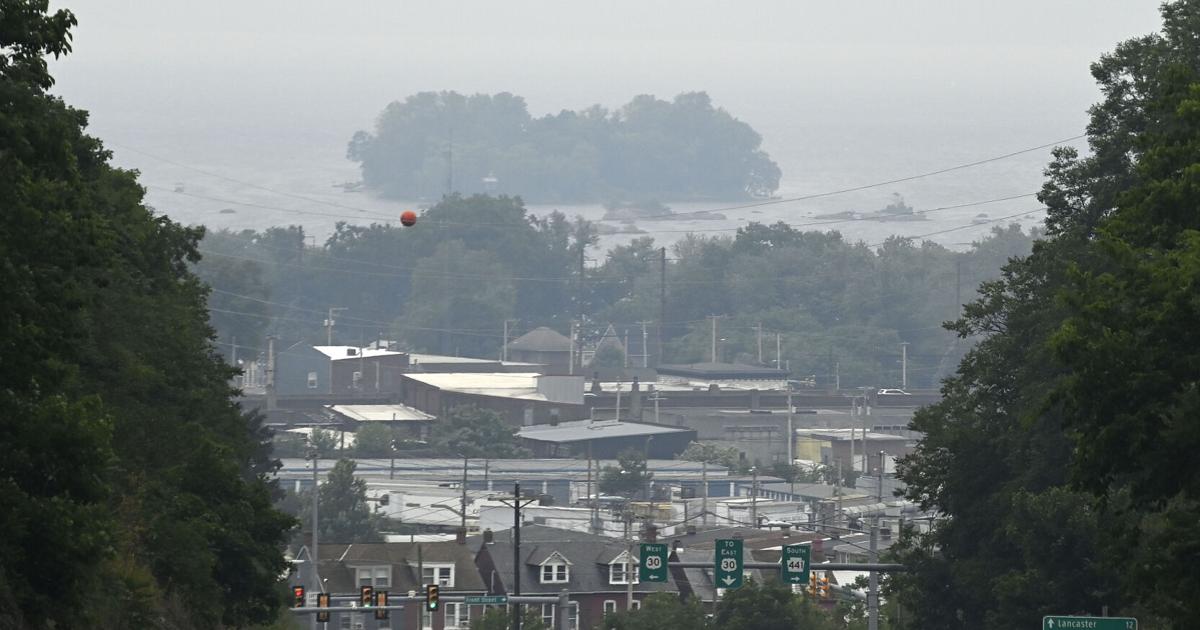The unusual weather patterns that funneled hazardous smoke from Canadian wildfires into Lancaster County last week and left the county with far less rain than usual are unlikely to become a recurring event, according to local experts.
“It’s been a crazy start to the summer,” said Kyle Elliott, director of the Millersville University Weather Information Center, “and we haven’t had something like this in 20 years.”
A similar pattern occurred here in the early 2000s, when a transition from La Niña to El Niño brought Lancaster County its driest year on record in 2001 and then contributed to smoke from Canadian wildfires impacting air quality in July 2002, Elliott said.
According to data from the weather information center, only 22.68 inches of precipitation was recorded in the county in 2001, the lowest amount in the 109 years of data documented by the center.
El Niño and La Niña are climate phenomena that start with temperature changes in the Pacific Ocean and spark worldwide weather changes.
During the transition period between the two, both branches of the jet stream air current are weak and unable to draw the moisture from the ocean needed to fuel strong storms.
The weather information center has registered 10.36 inches of precipitation for Lancaster County through May, just over 6 inches less than in the same time period in 2022.
“There’s just not a lot of energy out there to support storm systems and heavy precipitation,” Elliott said. “So I think that’s why we’re stuck in this drought right now.”
After rain, Lancaster County commissioners opt to wait another week before lifting fire ban
Wednesday’s rain made little impact to ongoing drought
Why recent smoke was different
Last week a low-pressure area in the upper level of the atmosphere drew smoke from the Canadian wildfires into Lancaster County and forced the polluted air much closer to the ground than normal, said Paul Pastelok, senior meteorologist for AccuWeather in State College.
Pastelok said it’s not unusual for smoke from wildfires in the western United States and Canada to be swept into Lancaster County, but that haze normally remains in the upper part of the atmosphere and is less concentrated due to the distance it has traveled.
That haze pattern has become increasingly common in the past 10 to 15 years and is likely to persist, said Brett Anderson, a senior meteorologist for AccuWeather out of State College, who specializes in Canadian weather.
Lancaster County normally experiences westerly winds, but air patterns like last week’s can bring more wind from the north and northwest, increasing the county’s exposure to wildfire smoke from closer areas of Canada, Pastelok said.
Last week’s wildfire smoke came from Quebec, and the circumstances that pushed that smoke close to ground level are unlikely to occur again this summer and will likely remain rare for the next 10 to 20 years, Anderson said. More than 2.5 million acres have burned in Quebec this year, according to the Canadian Interagency Forest Fire Centre.
Canadian wildfires pose a lesser risk to Lancaster County air quality than more local fires, Anderson added.
Climate change has brought more rain to Pennsylvania but it’s also brought less snow, he said, and rising temperatures can elevate fire risk in a dry year.
“You know over the coming decades here in Pennsylvania that the threat for larger spring fires may be increasing,” Anderson said.
Wildfire risk in Pennsylvania and New York is highest late March through April, Anderson added.
After the snow cover is gone, strong sun and wind can create rapid fire spread in forests that haven’t yet gained leaves, Anderson said. That threat is reduced in May and June as the forest canopy grows.
Because prevailing winds blow west to east, the county is unlikely to suffer similar effects from worsening wildfire seasons in areas like New Jersey, Elliott said.
“We’re not going to deal with these bouts of incredibly poor air quality on an annual basis,” Elliott said.















.jpg?width=1200&auto=webp&quality=75&crop=3:2,smart)

